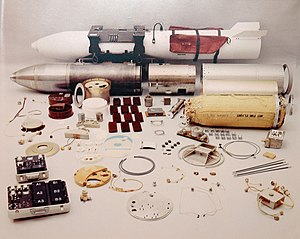
Back القنبلة النووية بي 83 Arabic Bomba atòmica B83 Catalan B83 (Kernwaffe) German Bomba nuclear B83 Spanish B83 Finnish B83 (bombe nucléaire) French B83 (bom nuklir) ID B83 Italian B83 (核爆弾) Japanese B83 핵폭탄 Korean
| B83 | |
|---|---|
 B83 with unclassified components at front | |
| Type | Unguided bomb |
| Service history | |
| In service | 1983–present |
| Used by | United States |
| Production history | |
| Designer | Lawrence Livermore National Laboratory |
| No. built | 650 |
| Specifications | |
| Mass | 2,400 pounds (1,100 kg) |
| Length | 12 feet (3.7 m) |
| Diameter | 18 inches (46 cm) |
| Blast yield | 1.2 megatonnes of TNT (5.0 PJ) |

The B83 is a variable-yield thermonuclear gravity bomb developed by the United States in the late 1970s that entered service in 1983. With a maximum yield of 1.2 megatonnes of TNT (5.0 PJ), it has been the most powerful nuclear weapon in the United States nuclear arsenal since October 25, 2011 after retirement of the B53.[1] It was designed by Lawrence Livermore National Laboratory.[2]
- ^ Blaney, Betsy (26 October 2011). "End of an Era: Last of Big Atomic Bombs dismantled". San Francisco Chronicle. Archived from the original on 28 October 2011. Retrieved 27 October 2011.
- ^ Sublette, Carey (11 November 1997). "Nuclear Weapons Archive - B83". Archived from the original on 4 February 2006. Retrieved 23 December 2013.
© MMXXIII Rich X Search. We shall prevail. All rights reserved. Rich X Search